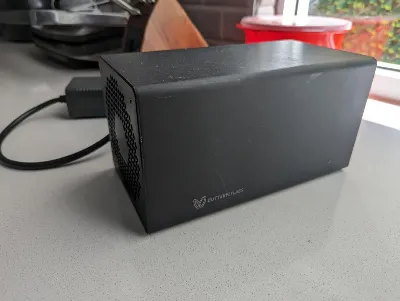THE BUTTERFLY EFFECT
June 16, 2012
1BTC:$6.400000
- Artist
- Fact Date
- Fact #
- undefined
- Printing Specifications
- Paper / Stock
- Page Size
The bitcoin mining arms race ramped up in 2012 with the emergence of the ASIC – a new type of hardware that promised to find blocks faster than ever. Manufacturer Butterfly Labs took hundreds of pre-orders at 5,000 BTC per machine before dragging its heels and ultimately failing to deliver the mini-rigs. The company’s name still causes shivers in the mining community today.
Bitcoin has endured its share of scams and scandals over the years, but few still reverberate as strongly as Butterfly Labs (BFL). It had all started out so promisingly as well. As Bitcoin climbed in 2012, the idea of mining the now-valuable cryptocurrency for merely the price of power was tantalising. Particularly now there was a new technology that promised to extract bitcoins even faster. Whoever got their hands on one of these devices would effectively own a money printer. At least that’s how it seemed at the time when BFL began touting the first mass-market devices.
Like many other Bitcoin startups at the time, including Bitcoin Magazine, BFL went with a pre-order model to fund the construction of the high-tech ASIC (Application-Specific Integrated Circuit) devices. The U.S. company emerged as mining was transitioning from GPUs to specialized chips, and in June 2012 unveiled the BitForce line of ASIC-based mining rigs. With a promised performance leap of up to 1,000x faster than existing setups, it’s not just existing miners who were tempted to put in a pre-order – so were have-a-go hobbyists.

BFL’s pricing model ran from $149 for the entry-level model up to $30K for the highest-end Mini Rig. The company accepted presales in the form of dollars or BTC, and many buyers plumped for the latter option. That was to prove their second mistake, their first having been to trust BFL’s slick promises. As shipping deadlines were pushed back and then delayed again, the price of bitcoin kept creeping higher, giving those who’d paid in BTC a bad case of buyer’s remorse.
Pickaxes and Pipe Dreams
While there was something off about Butterfly Labs, there was nothing dubious about the underlying technology the company based its hardware upon. ASICs were not only real, but were about to radically alter the mining landscape, rendering it permanently out of reach of amateur GPU owners. Any dreams users might have had that ASICs represented a new paradigm that would democratize Bitcoin mining were laid to rest with the BFL debacle.
Seizing upon the adage about “selling pickaxes during a gold rush,” Butterfly Labs’ business model made a lot of sense when viewed from a distance. It was only once you zoomed in and examined the company, including its founders’ dubious business history, that cracks appeared. As one journalist later put it, “They didn’t sell pickaxes; they sold preorders for pickaxes.”
By the time Butterfly Labs succeeded in delivering a few dozen units, representing less than 1% of all orders, other ASIC manufacturers had entered the scene including Avalon. But with Bitcoin’s hashrate rising in lockstep with its price, the dream of getting rich from solo mining with a single rig likely never materialised even for those fortunate enough to get their hands on one.
The jury’s still out on whether Butterfly Labs ever had good intentions of fulfilling all the preorders it took or whether it was an exit scam from the start. Either way, the outcome was the same: thousands of investors lost out, only a handful of units were ever shipped, and would-be miners learned the hard way that often the most profitable thing you can do with bitcoin is simply hold onto it.
- Artist
- XXXXX
- BTC On this day
- June 16, 2012
- Market Cap
- $59,124,800
- Block Number
- 191,849
- Hash Rate
- 12.58 TH/s
- Price Change (1M)
25%
- Price Change (3M)
21%
- Price Change (1Y)
59%
